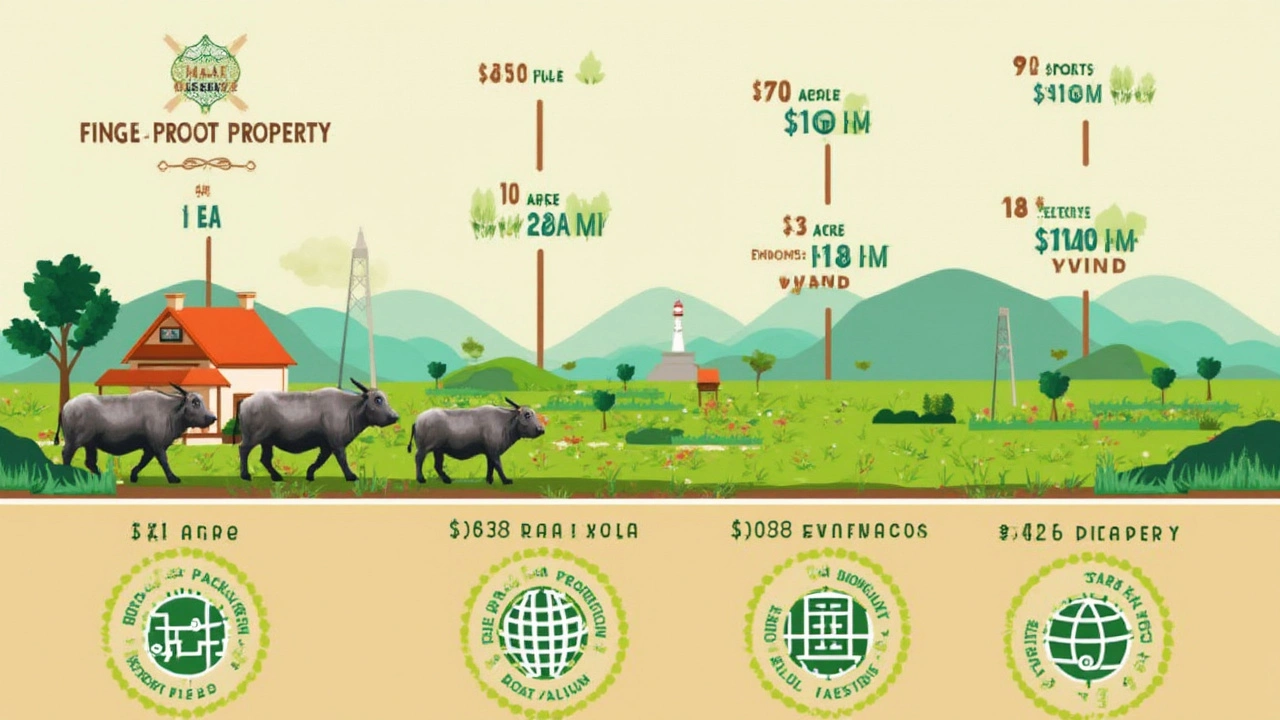Is 10 Acres Big Enough to Be a Ranch? Size, Uses & Real Ranching Facts

Picture this: you’re looking at real estate listings, and there’s a spread of 10 acres calling your name. The description says it’s a “mini ranch.” But hold up—is 10 acres really a ranch, or is someone stretching the definition like a cowboy’s lasso? Turns out, the answer isn’t as cut-and-dry as you’d think, mainly because the word “ranch” means different things to different folks, and its real definition has a lot to do with what you want to do with the land. Whether you’re sizing up your dream farmhouse spot or just daydreaming, it’s time to get clear on how 10 acres stacks up in the ranching world.
What Actually Makes Land a “Ranch”?
Let’s get the basics out of the way—what is a ranch, anyway? Traditionally, ranches in the U.S. are big properties used mainly for raising livestock, like cattle, horses, goats, or even bison. The word conjures images of rolling fields, sagging barns, and maybe a dusty pickup truck or two. But here’s where things get fuzzy: there’s no legal or official minimum size for a ranch. In rural Texas, the average cattle ranch can run into thousands, sometimes hundreds of thousands, of acres. Some of the largest ranches—like King Ranch—measure over 825,000 acres. But head to suburban Colorado, and you’ll see plenty of five- or ten-acre parcels proudly branded as “ranchettes” or hobby ranches.
Technically, if you’re raising livestock for business or even pleasure and you’ve got facilities like pens, shelters, and maybe a riding arena, lots of people will call that a ranch. Realtor.com lists tons of “ranches” between 5 and 20 acres, especially in states where land is at a premium. In a survey by Land Report, more than 40% of buyers said they viewed any tract used for livestock husbandry as a ranch, regardless of size. However, if you asked an old-school rancher from Montana if 10 acres was a ranch, you’d probably get a chuckle.
The bottom line? “Ranch” isn’t about an exact number—it's about your land’s purpose and your local norms. 10 acres ranch pops up in plenty of listings because it fits the smaller end of the hobby ranch spectrum.
How Does 10 Acres Compare to Classic Ranches?
If you want a wild fact to put things in perspective: the average size of a U.S. cattle operation, according to the USDA, is nearly 442 acres. And even that’s dwarfed by the mega-ranches of the Southwest and Northern Plains. But does that mean your 10-acre slice is out of the running? Not at all. For most folks looking to get out of the city and start a quieter, land-focused life, even a few acres feel sprawling.
Let’s break down how 10 acres measures up compared to typical land uses:
| Type | Average Size (US) | Common Uses |
|---|---|---|
| Urban Home Lot | 0.2 to 0.3 acres | Single house with a yard |
| Small Farm | 10 to 50 acres | Market gardening, few animals |
| Hobby Ranch/Ranchette | 5 to 40 acres | Horses, small livestock, recreation |
| Commercial Ranch | Several hundred to thousands of acres | Cattle, large livestock herds, crops |
So, 10 acres is nowhere near the size of even a classic small commercial ranch, but it sits comfortably in the ranchette camp, especially if you focus on small-scale livestock or horses. 10 acres equals about 7-8 football fields side by side—that’s a ton of space compared to town.

What Can You Actually Do With 10 Acres?
This is where it gets fun. On 10 acres, you’re playing in that “hobby ranch” or “lifestyle property” zone. For people craving country life without running a huge operation, it’s actually a sweet spot. Here’s what you could pull off with 10 acres:
- Keep a handful of cows or steers for beef (2-3 head is realistic without buying extra hay, depending on pasture condition and local rain)
- Raise goats, sheep, or alpacas—these critters need less space per animal
- Set up a modest horse property, with enough pasture for 2-3 horses and still have space for a barn and arena
- Start a market garden, orchard, or even a small vineyard if you’re into agri-tourism
- Leave half wild, managing a natural area for birds, deer, or bees
- Grow hay or specialty crops for side income
Of course, your plans can change everything. If you dream of hosting big herds, you’ll need much more land—here’s where 10 acres can feel tight. Grazing experts suggest about 2-5 acres per adult cow/calf pair in lots of the country, but in drier states, it might take over 15 acres per animal to avoid overgrazing. Horses don’t need as much, but crowd more than three onto 10 acres, and you’ll be feeding hay all season. If you rotate pastures and manage the land well, you can really make those acres work.
Legal Definitions, Zoning, and Real-Life Ranching
If you’ve ever peered at county zoning maps, you’ll know not all “ranches” are approved equal. Local rules matter—a lot. Some areas require as little as 2-5 acres for animal permits; others bump the minimum size up to 20 acres (and plenty ban livestock altogether inside city limits). Real ranches, hobby or otherwise, almost always come with ag zoning—or at least rural residential labels—so double-check your county rules. If you want to call your patch a ranch, putting up a cool gate sign isn’t enough if animal restrictions get in your way.
Tax breaks are another big deal. Some states, like Texas, give huge property tax discounts for agricultural use—but you often need at least 10 acres in active production, and there’s paperwork to prove you’re legit. Neighboring states might set the minimum at 20, 40, or even 160 acres. Always check with the assessor’s office if you’re counting on ag exemptions.
What about resale value? 10-acre ranches sell well to folks seeking quiet, privacy, and a taste of the farm life without going full cowboy. These properties tend to sit at a sweet spot: big enough to escape your neighbors, small enough to take care of yourself. According to Zillow’s 2024 report, "ranchettes" between 5 and 15 acres in Texas and Colorado increased in value roughly 18% over the last three years, outpacing both city homes and mega-ranches (which can be a harder sell for the average buyer).

Tips for Turning 10 Acres Into Your Own Ranch
Ready to put a cowboy hat on your 10 acres and live out those ranch dreams? The best advice: start with a plan and don’t underestimate the work. Here are some time-tested tips if you’re eyeing a 10-acre ranch property:
- Water first: Livestock or no livestock, a strong well or dependable water source is non-negotiable.
- Check fencing and access: Ten acres mean more boundary to fence, and you’ll want solid gates for animals and equipment.
- Buildings: Plan for a barn, tack room, tool storage, and possibly a guest bunkhouse. Think about where you’ll park that tractor or ATV, too.
- Pasture management: Divide your 10 acres into smaller sections (paddocks) if you’re grazing. Rotation protects your land and animals.
- Legal stuff: Get familiar with county laws, especially for animal numbers and building permits. Calling your spot a ranch looks cool on a sign but can’t fix a zoning ticket.
- Neighbors: Country living goes smoother when you get along with those around you. Ranching can mean the occasional noisy cow or loose goat—being proactive helps prevent feuds.
- Plan for growth: Dreaming of more animals later? Save a corner for future barns, arenas, or gardens.
- Do the math: Beyond buying the land, account for upkeep, tools, animals, hay, and emergencies. Ten acres eat up more cash than most new buyers expect.
One veteran horse owner in Oklahoma summed it up: “Ten acres was perfect for our family—enough pasture for two horses and the kids’ goats, but not so much I spent every evening mowing. Taught us discipline, too.” And that, honestly, is the charm of a 10-acre ranch.
So, is 10 acres a ranch? It sure can be—just maybe not in the same league as the rolling Texas spreads on TV. The real secret: it’s not about the number, it’s about what you do with it and what kind of country life you want. Sling some fence, bring a few animals, and you’ll feel like a rancher in no time.







Write a comment